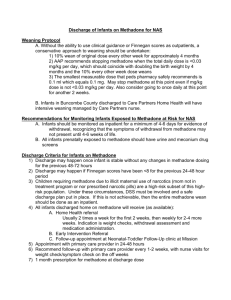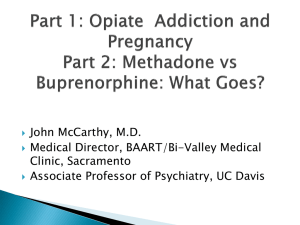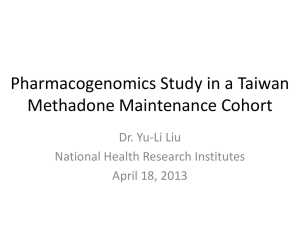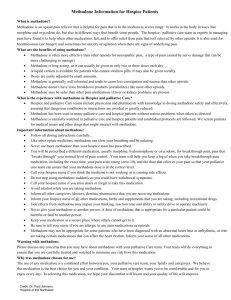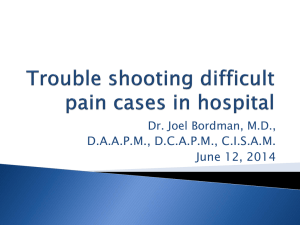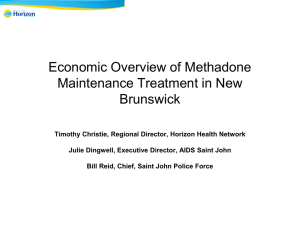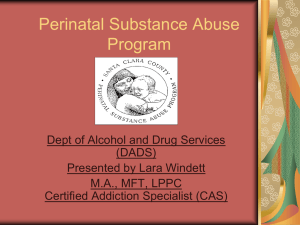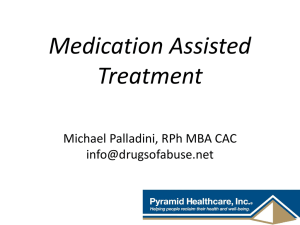Module 6
advertisement
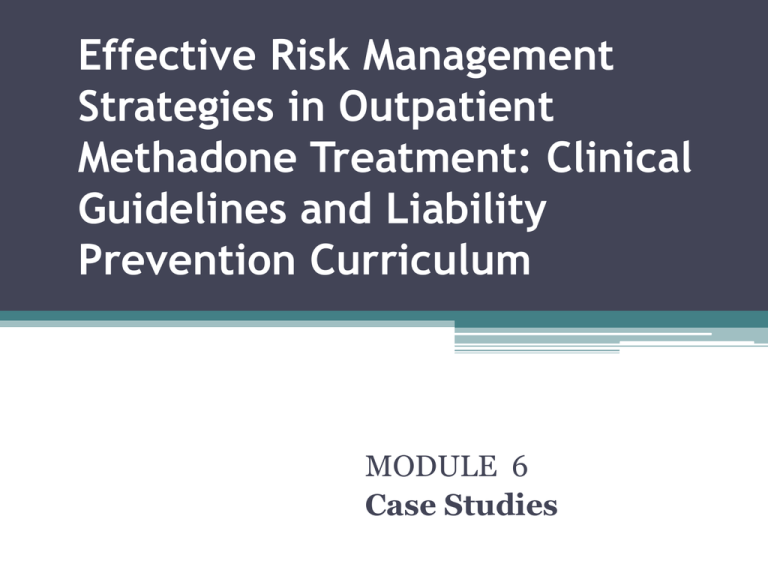
Effective Risk Management Strategies in Outpatient Methadone Treatment: Clinical Guidelines and Liability Prevention Curriculum MODULE 6 Case Studies Case Studies Overview • Case Study 1 – Admission / Induction • Case Study 2 – Take-Home Medication • Case Study 3 – Cardiac Arrhythmia 4 Mary: Presenting Information Mary is 28 years old “I need to get clean. I’m tired and run down and I don’t want to be a drug addict for the rest of my life because I know it’s going to kill me.” History of Present Illness • Onset of drug abuse as a teenager • Intravenous opioids during past 5 yrs • Oxycodone, “drug of choice,” heroin substitute • Denied use of opioid drugs for the past week and admitted withdrawal symptoms. • Symptoms had resolved and denies any for past three days. Past History of Treatment • Several admissions for inpatient and outpatient • Unable to sustain abstinence longer than 2-3 months • History of treatment for “depression” • “Self medicating” by increasing her drug use 7 Mary: Presenting Information • Mary’s physical exam revealed: • Vital signs within normal limits • Scattered scarring on her arms and hands • No fresh puncture wounds visible • Mary’s UDS was negative for: Amphetamines Barbiturates Benzodiazepines Cocaine Opioids Methadone and methadone metabolites 8 Mary: Treatment Plan Preliminary Treatment Plan: • The physician’s statement for documentation of current physiological dependence upon opioids was completed and signed. • Mary was recommended for admission to opioid maintenance treatment. 9 “Red Flags” • Diagnosis of Opioid Dependence • Documentation of current physiological dependence upon opioids • UDS results • Examine findings 11 Clinical Opiate Withdrawal Scale Last use (OPIOIDS) :Type, Date, Time Resting Pulse Rate: _________beats/minute Measured after patient is sitting or lying for one minute 0 pulse rate 80 or below 1 pulse rate 81-100 2 pulse rate 101-120 4 pulse rate greater than 120 GI Upset: over last ½ hour 0 no GI symptoms 1 stomach cramps 2 nausea or loose stool 3 vomiting or diarrhea 5 Multiple episodes of diarrhea or vomiting Sweating: over past ½ hour not accounted for by room temperature or patient activity. 0 no report of chills or flushing 1 subjective report of chills or flushing 2 flushed or observable moistness on face 3 beads of sweat on brow or face 4 sweat streaming off face Tremor observation of outstretched hands 0 No tremor 1 tremor can be felt, but not observed 2 slight tremor observable 4 gross tremor or muscle twitching Restlessness Observation during assessment 0 able to sit still 1 reports difficulty sitting still, but is able to do so 3 frequent shifting or extraneous movements of legs/arms 5 Unable to sit still for more than a few seconds Yawning Observation during assessment 0 no yawning 1 yawning once or twice during assessment 2 yawning three or more times during assessment 4 yawning several times/minute Pupil size 0 pupils pinned or normal size for room light 1 pupils possibly larger than normal for room light 2 pupils moderately dilated 5 pupils so dilated that only the rim of the iris is visible Anxiety or Irritability 0 none 1 patient reports increasing irritability or anxiousness 2 patient obviously irritable anxious 4 patient so irritable or anxious that participation in the assessment is difficult Bone or Joint aches If patient was having pain previously, only the additional component attributed to opiates withdrawal is scored 0 not present 1 mild diffuse discomfort 2 patient reports severe diffuse aching of joints/ muscles 4 patient is rubbing joints or muscles and is unable to sit still because of discomfort Gooseflesh skin 0 skin is smooth 3 piloerrection of skin can be felt or hairs standing up on arms 5 prominent piloerrection Runny nose or tearing Not accounted for by cold symptoms or allergies 0 not present 1 nasal stuffiness or unusually moist eyes 2 nose running or tearing 4 nose constantly running or tears streaming down cheeks Total Score ________ The total score is the sum of all 11 items Initials of person completing Assessment: ______________ Score: 5-12 = mild 13-24 = moderate 25-36 = moderately severe more than 36 = severe withdrawal Source: Wesson, D. R., & Ling, W. (2003). The Clinical Opiate Withdrawal Scale (COWS). Journal of Psychoactive Drugs, 35(2), 253-259. Upon admission, Mary was started on methadone. 13 Mary’s Induction Schedule Mary’s dosing schedule per standing orders: Day 1 Day 2 Day 3 Day 4 Day 5 Thurs. Fri. Sat. Sun.(TH) Mon. Methadone dose 30mg Methadone dose 40mg Methadone dose 50mg Methadone dose 60mg Methadone dose 65mg 14 Mary: Induction Day 1 • Mary was started on a dose of 30 mg methadone with a standing order to increase 5 to 10 mgs daily Day 2 • Mary received a dose of 40mg of methadone Day 3 • • • Mary reported withdrawal symptoms Mary received an increased dose of 50 mg Mary given TH 60 mg for Day 4, Sunday 15 Mary: Complications Day 4 • TH dose 60 mg Day 5 • Mary reported no withdrawal symptoms and did not want an increase • Mary was noted to be slightly unsteady on her feet • Mary given 65 mg of methadone as per standing orders Day 6 • Mary was a no-show • Counselor made outreach call and was informed Mary passed away the day before 16 Mary: Autopsy An autopsy was performed 48 hrs after Mary’s death. The report stated: The Circumstantial Cause of Death due to pulmonary edema secondary to methadone intoxication The forensic toxicology report indicated high levels of methadone and methadone metabolites 17 A Road-Map to “Steady State” 450 400 350 Methadone dose levels 300 ng/ml 250 200 150 100 50 0 1 2 3 4 5 6 7 8 Days/Half-Lives – Methadone half-life= 24-36 hours Dose constant at 30 mg daily. Interdose interval = 24 hrs (trough to trough) Peak levels increase daily for 5-6 days with NO increase in dose! Source: Payte;Center for Substance Abuse Treatment,Medication-Assisted Treatment for Opioid Addiction in Opioid Treatment Programs,Treatment Improvement Protocol (TIP) Series 43, DHHS Publication No. (SMA) 06-4214.Rockville, MD: Substance Abuse and Mental Health Services Administration, 2005,reprinted 2006. Methadone Dose “Equivalent Effect” • • • • • • Day 1 Thurs Methadone dose 30mg 30mg Day 2 Fri Methadone dose 40mg 55mg Day 3 Sat Methadone dose 50mg 77.5mg Day 4 Sun (TH)Methadone dose 60mg 98.75mg Day 5 Mon Methadone dose 65mg 114.37mg Day 6 Tue No Show Methadone “dose equivalent effect” due to accumulative effect of tissue buildup 19 Induction: Summary • Everyone is responsible for best practice and risk management ▫ Provide a thorough, comprehensive assessment ▫ Establish diagnosis “current physiological dependence upon opioids” • Avoid standing orders ▫ Dear Colleague letter from Dr. Clark in Sept. 4, 2007 • Observe and document carefully • START LOW and GO SLOW • Respond to patient complaints and changes in status Stan: Presenting Information Stan is a 35 y/o AAM • Long history of snorting heroin/oxycontin • Titrated to methadone 120 mg • Requested THs due to work hardship ▫ Given 5 TH doses per week by week 4 ▫ First two UAs negative Stan: Complications • By month 3: ▫ Stan had missed several counseling appointments ▫ 1 week later his UA is positive for oxycodone ▫ Stan had a party and a 21 year old died after taking Stan’s methadone ▫ Lawsuit brought against OTP Take-Home Medication: Summary • Follow policy and procedures ▫ Receive all TH bottles at next visit ▫ Random callbacks (quantitative) ▫ Urine drug screens on patient with expanded TH (hardship) • Explore alternatives to lower risk and make the OTP work better for the patient ▫ Change hours ▫ Open 7 days • What is the clinics responsibility to third parties? Glenn: Presenting Information Glenn is a 36 y/o white male • Methadone dose - 300 mg • Transferred to a new program • No cardiac history • No other medications • Physical Exam: ▫ Marfanoid habitus ▫ Bronchitis ▫ The remainder of exam was normal • Father with heroin addiction • Dose increases began at 25-35 mg Glenn: Treatment • November ▫ 435 mg ▫ Feeling “10% better” • February ▫ 600 mg ▫ Feeling “30% better” ▫ Dilated pupils at trough • March – ▫ 660 mg ▫ Feeling “50% better” ▫ Call from the ER -ventricular tachycardia (TdP) Glenn: Complications • Glenn continued to have repeated episodes of ventricular tachycardia • Over the next few days: ▫ Methadone reduced over next 4 days to 100 mg every 6 hours ▫ Glenn received an Intra Cardiac Defibrillator (ICD) and temporary pacemaker ▫ Ongoing withdrawal symptoms Dose increased, but resulted in ongoing firing of ICD Glenn: Outcome • Ultimately Glenn’s treatment results in: ▫ 420 mg of methadone with complaints of withdrawal symptoms ▫ Gradual increase in dose to 600 mg ▫ Dose remains at 600 mg with 1-2 episodes monthly of the ICD firing Torsades de Pointes (TdP): Summary • Cases of Torsades de Pointes are rare • Mostly associated with methadone >200 mg • QTc may be prolonged ▫ Some have occurred with normal QTc ▫ Majority of prolonged QTc do not result in cardiac problems • CSAT convened a Cardiac Expert Panel in 2008 to provide recommendations for QTc Interval Screening in Methadone Maintenance Treatment, final published report is pending Torsades de Pointes (TdP): Summary • The American Association for the Treatment of Opioid Dependence (AATOD) recommends a thorough exam including: ▫ Patient’s history ▫ Family’s history ▫ Physical exam • Ask your patients if they have: • Any heart related symptoms, problems • Fainting spells • Palpitations • Unexplained seizures • Family history of any of the above • Other drugs that can prolong QTc intervals. • If risk factors are present, order an ECG
